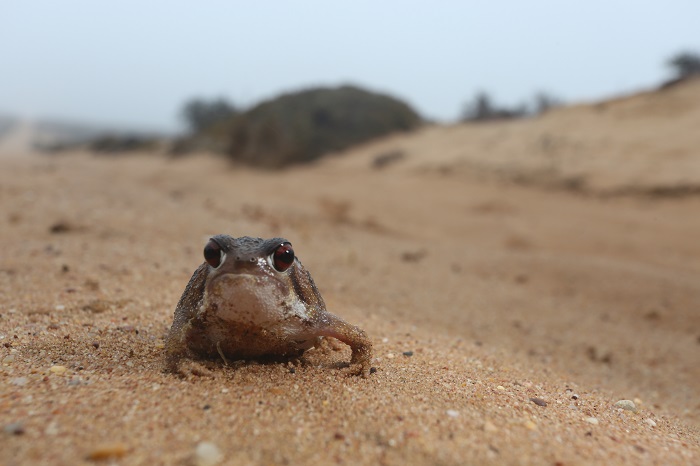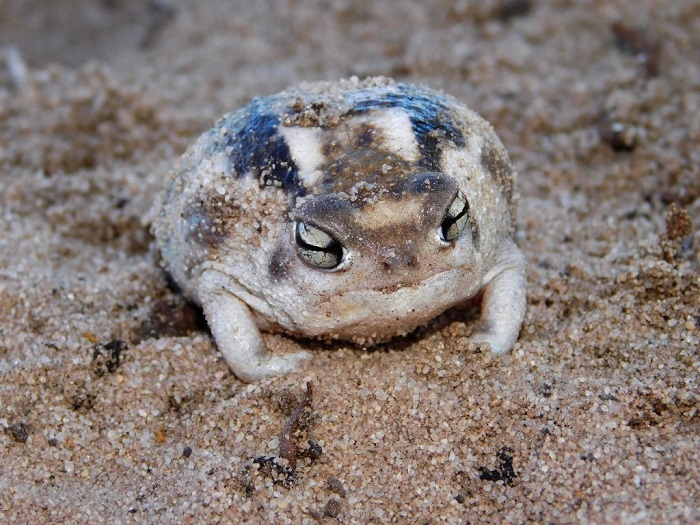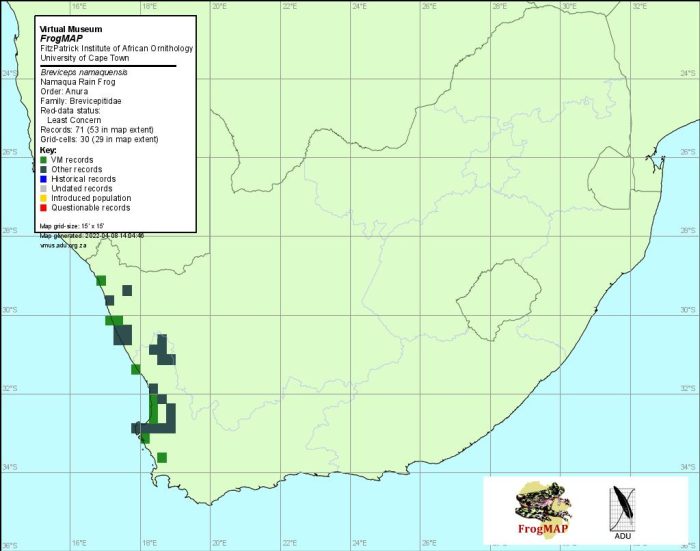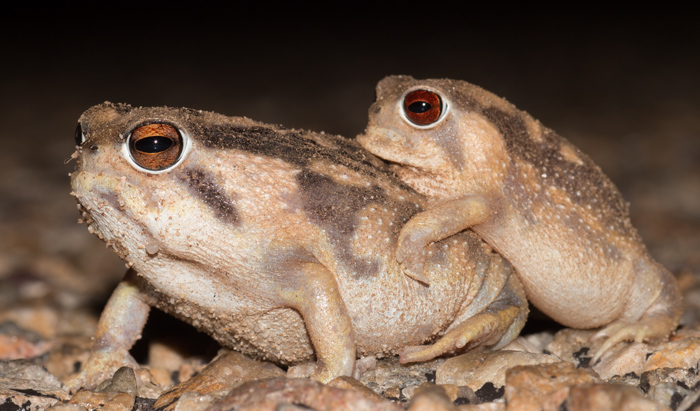View the above photo record (by Vaughan Jessnitz) in FrogMAP here.
Find the Namaqua Rain Frog in the FBIS database (Freshwater Biodiversity Information System) here.
Family Brevicepitidae
NAMAQUA RAIN FROG – Breviceps namaquensis
Power, 1926
Habitat
B. namaquensis appears to favour scrub-covered, deep, and principally red sands in the Succulent Karoo Biome, specifically in the Strandveld and Lowland Succulent Karoo vegetation types. The harsh, brackish soils of the Knersvlakte are avoided. Unlike B. macrops, this species is not confined to coastal dunes and substantial populations were encountered in the interior.

Photo by Erlo Brown
Behaviour
Little is known of the life history of B. namaquensis; presumably it is similar to that of other members of the genus.
Calling takes place mainly in winter and spring, during and following good rain. Sporadic calling has also been noted in early summer and autumn in the western Richtersveld and during periods of heavy mist following recent rain (pers. obs.). Males call from concealed positions beneath vegetation, in scrub-covered sandy areas (pers. obs.; Channing 2001).

Photo by Trevor Hardaker
Advertisement calls of B. namaquensis, recorded by A. de Villiers at Rocherpan Nature Reserve, had an emphasized frequency of 1600 Hz rising to 2000 Hz. The calls were 160–165 ms in duration and were repeated at a rate of about one call per second (L.R. Minter pers. comm.). The calls of this species are higher pitched and much shorter than the calls of B. macrops (see species account). It makes a squeaky distress call; listen to it here.
Status and Conservation
B. namaquensis is protected by ordinances of the Northern Cape and Western Cape provincial nature conservation agencies. The species occurs in the Corridor West (2917AA, CA) area of the Richtersveld National Park and in the Rocher Pan Nature Reserve (A. de Villiers pers. comm.).
In the southern half of its range, certain parts of its habitat have been exploited for agriculture and development, but in general this species is not under threat.

Photo by Paul Bester
Because so little is known about B. namaquensis, it is recommended that further studies on its distribution and general biology be undertaken. Regular monitoring of protected populations is advisable and would certainly yield new and useful information.
Distribution
B. namaquensis is endemic to the atlas region. It occurs in the predominantly winter-rainfall Namaqualand region of the Northern Cape and Western Cape provinces, from near the Gariep (Orange) River in the north (2816DA) to the Melkbos district (3318CB, DA) in the south. V.C. Carruthers (unpubl. data) recorded a specimen of B. namaquensis disgorged by a snake near Elands Bay (3218AD). The escarpment and the Namaqualand and Richtersveld mountains form the eastern limit of this species’ distribution.
In the northern part of its range in Port Nolloth (2917AC), Holgat River (2816DD), Alexander Bay (2816CB) and surrounding districts, B. namaquensis occurs in sympatry with B. macrops. It is sympatric with B. rosei in the southern reaches of its range. Morphological and call differences between the three species easily separate them, and the atlas data are reliable. Gaps in the recorded distribution of this frog probably indicate inadequate surveying rather than a real absence of the species.

Further Resources
Virtual Museum (FrogMAP > Search VM > By Scientific or Common Name)
Article in The Guardian Newspaper: The squeaky Namaqua Rain Frog
More common names: Namakwa Reënpadda (Afrikaans)
Recommended citation format for this species text:
Braack HH, Tippett RM. Namaqua Rain Frog Breviceps namaquensis. BDI, Cape Town.
Available online at http://thebdi.org/2021/12/17/namaqua-rain-frog-breviceps-namaquensis/
Recommended citation format:
This species text has been updated and expanded from the text in the
2004 frog atlas. The reference to the text and the book are as follows:
Braack HH 2004 Breviceps namaquensis Namaqua Rain Frog. In Minter LR
et al 2004.
Minter LR, Burger M, Harrison JA, Braack HH, Bishop PJ, Kloepfer D (eds)
2004. Atlas and Red Data Book of the Frogs of South Africa, Lesotho and
Swaziland. Smithsonian Institution, Washington, and Avian Demography
Unit, Cape Town.

